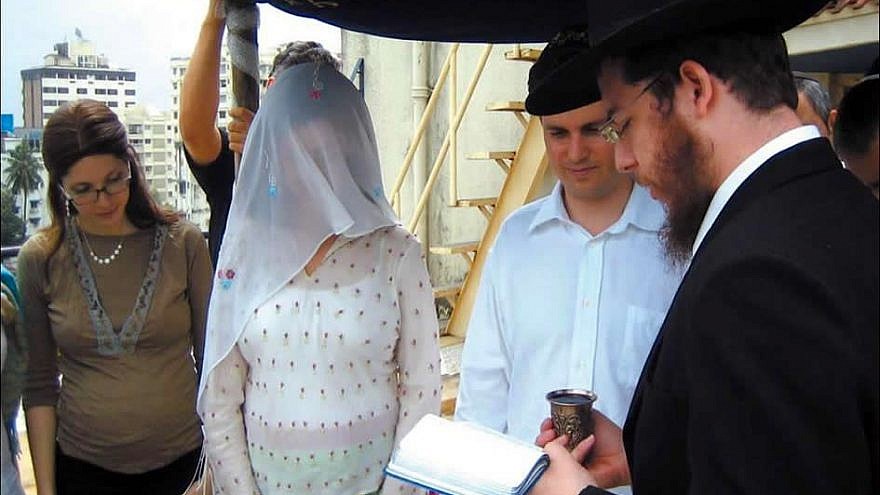Ten years ago, on a cold, overcast Friday morning in Brooklyn, N.Y., reporters filled the lobby of the Jewish Children’s Museum for a hastily arranged press conference. The previous 48 tense, unsettling hours had jumped and crawled to a final, shocking conclusion.
“With profound sadness and deep sorrow, we received the definitive news, just a short while ago, confirming the brutal murder of two of our finest, Rabbi Gavriel Noach, 29, and Rivka Holtzberg, 28, our dear representatives in Mumbai, India, who served their community with love and devotion,” announced Rabbi Yehuda Krinsky, chairman of Merkos L’Inyonei Chinuch, the educational arm of the Chabad-Lubavitch movement.
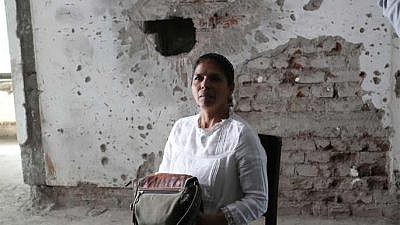
Pakistani Muslim terrorists had laid waste to the city of Mumbai, killing men, women and children in hotels, a train station and on the streets of the city formerly known as Bombay—164 would be the ultimate death toll—but the fate of the hostages held at the Chabad House, or Nariman House, had not been known until the last, bitter moment.
The confirmation sent shockwaves throughout the world. “Rabbi and wife killed in Mumbai,” reported an outlet as distant as the Times of Malta, noting that the couple had “arrived in Mumbai in 2003 to serve the small Jewish community there, running a synagogue and Torah classes, and assisting Jewish tourists to the seaside city.”
People wanted to know about the Holtzbergs. “What Were Orthodox Jews Doing in Mumbai?” asked Slate. The answer came in the form of numerous firsthand accounts—men and women who had encountered Gabi and Rivky, as they were known, in the years they had run Chabad of Mumbai. It came in the hundreds of memorial events that took place in the days and weeks that followed, and the tens of thousands of mitzvot, and acts of goodness and kindness taken on by perfect strangers moved by the selfless dedication of the martyred couple. And it came in the continuation of the Chabad work that the Holtzbergs had begun and been denied the chance to carry on. The Shabbat following the attacks, rabbinical students were in Mumbai to organize and run the Chabad Friday-night meal. Five years ago, a permanent emissary couple—Rabbi Yisroel and Chaya Kozlovsky—arrived in Mumbai, and in 2014, the Chabad House reopened its doors once again.
But memory of the Holtzbergs remains in Mumbai to this day.
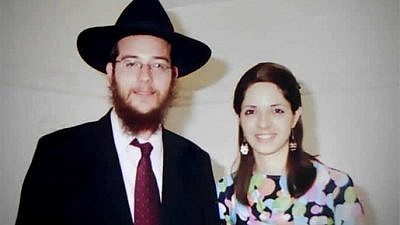
“They were here for less than five years,” says Rabbi Kozlovsky. “We’ve already been here longer than they were. But what they accomplished in five years, I don’t think I’ll do in 20.”
Even now, a decade later, it’s impossible to shake the vision of the Chabad House in Mumbai under siege, treated not as a house of prayer and kindness on a nondescript side street in the business capital of India, but as an embassy of the Jewish people to be targeted and destroyed in an act of war.
Indeed, what were the Holtzbergs doing in Mumbai? How did this all happen?
Faraway Mumbai
The smell, the noise, the dirt. Chaotic Mumbai assaults the senses. Its never-ending heat and humidity exhausts, and summer monsoons bring torrential rains, transforming narrow streets into rivers of flowing mud. For the visitor, Mumbai’s everyday reality is a constant reminder that they are far, far away from home.
“It’s a sensory overload,” says Erin Beser, who first landed in the city of 18 million in the summer of 2006, staying for a year. As an American Jewish Joint Distribution Committee (JDC) volunteer in Mumbai, Beser came to work with the local Bene Israel Indian Jewish community. It was during the orientation—when JDC volunteers a year ahead of Beser showed her the ropes and introduced her to the Jewish scene in the city—that a fellow volunteer led her to Mumbai’s Chabad center for Friday-night Shabbat dinner, saying that it was a “place where you can just be.” There, she met Rabbi Gabi and Rivky.
Unlike other Chabad outposts in Asia, most of Chabad of Mumbai’s regulars were not the ubiquitous Israeli backpackers, who prefer to strike out for India’s scenic north, but Israeli and international Jewish businesspeople—volunteers like Beser—and NGO employees based in the city. For Beser, her expectations of what Jewish life in Mumbai would look like were “surpassed. I was surprised by how much I enjoyed it.”
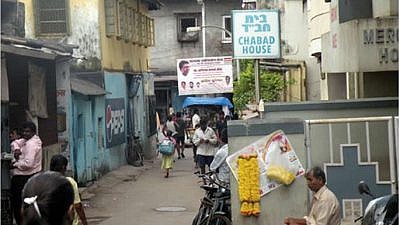
The Holtzbergs had only a few years earlier moved their center into Nariman House, a new construction on a side alley in the tourist-heavy Colaba district they purchased with the help of the New York-based Rohr family. Beser remembers Gabi and Rivky living on one floor, with another being used for events, classes and meals. But they had big plans for the rest of the six-story building. Beser became a regular, coming with friends on Friday nights or simply dropping by before a Jewish holiday just to “schmooze with Rivky.” Far from her own hometown of Baltimore, the Chabad House was a splash of the familiar, especially during her first few months in Mumbai before her roommate arrived.
“You’d walk into their apartment, and it was bright, white, clean,” says Beser, today 34. Rivky would bake challah every week, the aroma wafting through Nariman House. “It was just a cool atmosphere; it was very comforting.”
At Shabbat meals, Gabi Holtzberg had instituted an icebreaker; going around the table, guests were each asked to share a song, story or a d’var Torah—words of Torah. Beser liked to choose the words of Torah option, hoping to good-naturedly spar with the rabbi. Although he didn’t take the bait, “I think he liked it,” she says.
For Gabi, his day could typically begin by performing a brit milah (circumcision)—he was a trained mohel—go on to give a Torah class and then head out to slaughter kosher meat before rushing to tend to an emergency, perhaps visiting an Israeli backpacker in trouble with the authorities. It was Rivky holding down the fort at the Chabad House, and it was Rivky with whom Beser bonded most. Rivky was outgoing and welcoming, even in the late stages of pregnancy. Beser remembers Rivky going back to Israel for the birth and returning with a new baby boy, Moshe. Rivky never mentioned that they had another child, ill with Tay-Sachs, in a facility in Israel—something Beser would only learn later from others.
“Rivky was one of the bravest, toughest people I ever met,” she says. “To have a baby sick, to be pregnant, to be far from home, and to keep going and navigating life, I had enormous respect for her.”
Throughout the year, when senior JDC staff or other guests would visit Mumbai, they would all head to the Chabad House for the convivial environment. And there were the little things: Beser recalls the Holtzbergs working hard to help her roommate get kosher meat or arranging sleeping arrangements for them near Chabad if the young women didn’t want to make the long trek back to their apartment late on a Friday night. She left Mumbai at the end of the summer of 2007, giving Rivky a parting hug. “Be’ezrat Hashem—with G‑d’s help—we’ll see each other again,” she remembers telling her.
The next time she saw Gabi and Rivky was a little more than a year later, while volunteering in Turkey, watching the Mumbai terror attacks unfold on a flickering screen.
Nov. 26, 2008
It was late morning on a cold winter day in Brooklyn when Motti Seligson, director of media relations at Chabad.org, got an unexpected call from a journalist source. “Check up on your guy in Mumbai,” he cryptically told him. Seligson glanced at the news. Seeing nothing, he gave the rabbi a call. He then tried an office number, then the home line. Nothing worked.
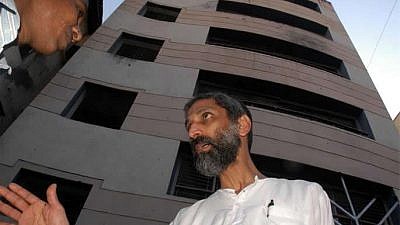
Reports began appearing in the national media of a massive coordinated attack unfolding in Mumbai; Pakistani Muslim terrorists from the Lashkar-e-Tayyiba group were unleashing hell upon the city. Seligson called both sets of parents to double-check that the Holtzbergs were indeed still in Mumbai at the time. They were.
“We started getting concerned,” says Seligson, “but we hadn’t yet considered that they had been targeted.”
As detailed by Rabbi David Eliezrie in his 2015 book, The Secret of Chabad, a crisis-management team was quickly set up at Lubavitch World Headquarters in the Crown Heights neighborhood of Brooklyn, although there was still some question as to what exactly the crisis was. “They set up communications with India and began monitoring media and government sources of information,” writes Eliezrie, including paying close attention to social-media channels, such as the relatively new Twitter.
News from Mumbai was bleak. The terrorists had split up and were assaulting multiple sites across the city, including a 90 minute bloodbath at the massive central train terminus, shooting up the Leopold Cafe, and attacking guests and holing up at the Taj Mahal Palace and Tower Hotel and the Oberoi-Trident Hotel. The terrorists had attempted to attack a hospital, killing police outside, and planted bombs in taxis that went off later, also killing people. Realizing the degree of the carnage unfolding, Seligson remembers the team in Brooklyn faxing pictures and descriptions of the Holtzbergs to Mumbai hospitals, hoping some information might come about that way.
But the terrible truth was that the Holtzbergs and their guests were being held hostage in the Chabad House. When the 10 terrorists had disembarked from their hijacked fishing boat at the Mumbai waterfront, two of them had headed straight to Chabad, later learned to have been a priority, entering only minutes after the shooting at the train station had commenced. Gabi had managed to call the Israeli consulate in Mumbai, telling them “Hamatzav lo tov—The situation is not good.”
Then the line went dead.
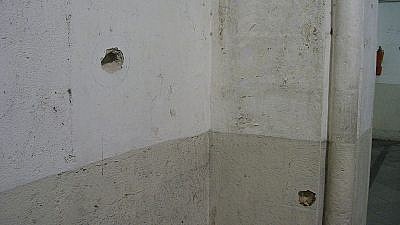
It was early evening when Meylekh (P.V.) Viswanath, a professor of finance at Pace University in New York, got a call from his nephew, who was connected to his local Chabad at Princeton University, telling him that Lubavitch Headquarters was searching for someone who could speak Indian languages. Viswanath, an observant Jew who lives in New Jersey, was born in India and had grown up there. After a conversation with those at headquarters, who asked him if he’d be able to translate from non-Anglo Indian media sources, Viswanath, who had previously met the Holtzbergs on his yearly visits to Mumbai, got into his car and drove to 770 Eastern Parkway in Brooklyn.
“I knew I wasn’t going for 15 minutes, but I had no idea that I would be spending the whole night there,” he says. “Nobody understood that yet.”
As time passed, it became clear that the Chabad House had not only been caught in the crossfire, but actually targeted, and the people inside were in deep trouble. Indian police evacuated the buildings adjacent to Nariman House, and Indian media set up nearby. In the United States, CNN was playing a feed from its sister station in India, IBN. Seligson called an acquaintance at CNN in Atlanta who put him in touch with IBN’s anchor on the ground, Raksha Shetty, who would serve as a valuable source of local intelligence amid the confusing barrage of real and false information.
That evening, Rabbi Levi Shemtov of American Friends of Lubavitch (Chabad) in Washington, D.C., dialed Gabi’s cell phone yet again, when someone picked up at the other end. It was a male; he spoke no English. “Urdu, Urdu,” insisted the voice. Viswanath, who speaks numerous languages, including Hindi—in many ways the same as Urdu—was by this time in Brooklyn, and a telephone connection was re-established at midnight Eastern Standard Time. The terrorist on the line told Viswanath that his name was Imran.
“At one point, we asked him if all the people there were conscious, because we had heard reports that some of them were unconscious,” Viswanath wrote in the Forward a week later. “Imran told us that everybody was fine: Nobody was hurt and they had not touched anybody. ‘We haven’t even slapped them around,’ he said.”
He was lying.
Endless night
For those on the crisis team in Brooklyn, the next dozens of hours were filled with tension, coffee and harried bathroom breaks. The connection with the terrorist was on and off. He demanded to be put in touch with a representative of the Indian government—something Shemtov tried doing through the Indian embassy in Washington.
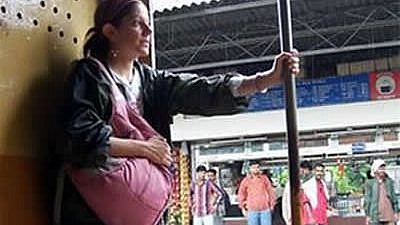
“It was a very heavy situation, but I was more worried about being able to translate properly and to say what needed to be said,” says Viswanath. “Obviously, it was a weighty situation, but I wasn’t thinking about the larger scheme of things.”
The voice on the other end was calm and, says Viswanath, did not sound evil. “He wasn’t saying I’m going to kill people or Jews are terrible—none of those things.” Another of the terrorists had been captured, and it seemed like he was willing to negotiate.
The phone call with New York wasn’t the terrorists’ only one. Throughout the attack, they remained in contact with their handlers in Pakistan via satellite phone, calls that were recorded and later released by Indian intelligence.
“As I told you, every person you kill where you are is worth 50 of the ones killed elsewhere,” the handler, called Pasha, later identified as former Pakistani military officer Abdur Rehman Hashim Syed, informed the terrorists in the Chabad House.
By this time, Indian commandos had surrounded Nariman House, perching snipers on nearby buildings. They exchanged gunfire with the terrorists, blowing out the windows of the Chabad House as the world watched. “There’s a child, there’s a child in there,” a shocked Indian commando could be heard shouting in subsequently released radio communication, with grainy video footage showing a little Moshe standing over the inert bodies of his parents.
A little after 11 a.m. Mumbai time, early morning in New York, there was a sudden break. A woman was seen running out of the building holding baby Moshe. Indian Sandra Samuel, his nanny, and Qazi Zakir Hussain, called Jackie, a Muslim cook at the Chabad House, had heard Moshe’s cries from their basement storage-room hideout and rescued him. Dramatic images of Sandra fleeing the building came as a relief to family members and those watching around the world, but also added to the confusion.
“As India reeled from a series of bloody attacks launched by Islamist extremists across Mumbai, Indian officials said Thursday that eight hostages held by terrorists at the city’s Chabad headquarters had been freed by security forces,” Haaretz reported at the time, quoting Indian media. “… However, several Israeli officials, including the Foreign Ministry, said the report was unverified and based on unconfirmed rumors … ”
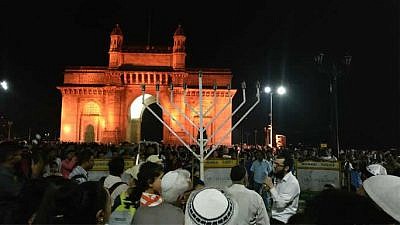
As the night progressed in New York, members of the NYPD’s counter-terrorism team and FBI agents arrived at 770. A hostage negotiator came as well, providing those who had been on the call with the terrorist tools to implement the next time they connected. They never did. Viswanath waited seven-and-a-half hours after the last conversation with Imran before heading home, exhausted.
“We knew hundreds of people had been killed in Bombay, but in the Chabad House we didn’t know,” he says, recalling the drive home. “It was still being treated like a hostage situation, so it was just waiting and seeing, hoping and praying.”
Hope that things would end well diminished as time passed. Although Israel had offered to send a trained team to attempt a rescue at the Chabad House, the Indian government rejected it, launching its own raid that would stretch on for hours, culminating in commandos landing on the roof of the center and making their way down floor by floor.
There were no survivors.
Shabbat dawns
The destruction of the Mumbai Chabad House in Mumbai, the murder of the emissaries who ran it and the guests who came there for Jewish comfort and warmth, was something unprecedented. And yet, the Jewish world had faced horrors before. So had Chabad. In 1956, Arab terrorists infiltrated the village of Kfar Chabad, Israel, and attacked the village’s vocational school, and killed one teacher and five students standing in the midst of silent prayer.
In the days that followed, the Rebbe, Rabbi Menachem M. Schneerson, of righteous memory, wrote letters of comfort to the families of the victims and the shocked villagers. More than anything else, he encouraged them to build, to expand their devastated village, to double their efforts and find comfort through this work. The encouragement was not meant to be metaphorical.
“[You] should begin with vigor the construction of the new building of the yeshivah and other buildings in the village . . . ,” he wrote to the vocational school’s directors, who opened a new branch of the school called Yad Hachamisha, or “Hand of the Five.” A month later, the Rebbe announced he would send a group of yeshivah students to Israel as his personal representatives to uplift the broken spirits of his Chassidim and all of Israel.
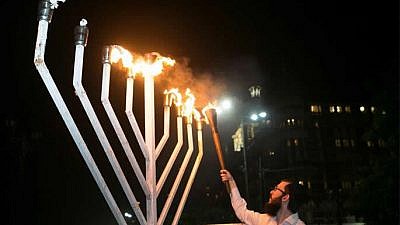
The aftermath of the Yad Hachamisha attack has for Chabad served as a blueprint for how to react to any circumstance of tragedy. The pain of Mumbai, deep and visceral—Moshe’s cries of “Ima” while holding an orange ball will never go away—was profound, but the response could only be the same, albeit intensified.
That Friday morning at the press conference in New York, Krinsky issued a public call on behalf of Chabad-Lubavitch:
“As the Shabbat approaches,” he said, speaking, through the international media, to the world, “we call upon Jewish women and girls to brighten the profound darkness the world is witnessing, and usher in the Shabbat by lighting the traditional Shabbat candles, 18 minutes before sunset. I am certain that this would be Gaby’s and Rivka’s wish.”
It was perhaps not uncoincidental that Krinsky had been a member of that same delegation sent by the Rebbe to Kfar Chabad a half-century earlier.
“This is the time to take strength,” an emotional Rabbi Moshe Kotlarsky, vice chairman of Merkos, who had been in close contact with the Holtzbergs, said at the Holtzbergs’ gut-wrenching funeral the next week. “This is not the time to ask questions, this is not the time to think, this is the time to do … Such brutal darkness can only be fought with torches, with torches of goodness and kindness and light … ”
Ten years later
Erin Beser, in Turkey volunteering with the JDC, had followed the news out of Mumbai as close as she could. She still had plenty of friends there; JDC volunteers in the city had been evacuated on Thursday evening, and a group of Indian Jews she knew had gone down to the area near Chabad House to try to see what was going on and if they could help.
Learning that day that the Holtzbergs were gone “was surreal,” she says. People around her in Turkey knew that she had been in Mumbai and had personally known those killed, offering her condolences. Still, what had actually happened has never fully registered. “In a way, for me, they’re still there,” she says, “but that place doesn’t exist.”
The Holtzbergs changed countless lives during their short time on earth and even more after their deaths sanctifying G‑d’s name. The coming months will mark 10 years since their murder, but also the 10th birthdays of hundreds of boys and girls named after them, and the 10th anniversary of donning tefillin every day or lighting Shabbat candles every week for innumerable Jewish men and women. A Jewish day-school scholarship fund named for Gabi and Rivky in Portland, Ore., will celebrate a decade of existence, and a Shabbat-meals delivery project in their memory in British Columbia will do the same.
Beser knew that the anniversary was coming up. Her 10-year Indian visa recently expired, which meant this round date was approaching. Today the director of community learning and engagement at the Jewish Community Project Downtown in Manhattan, Beser constantly draws lessons from her time in India.
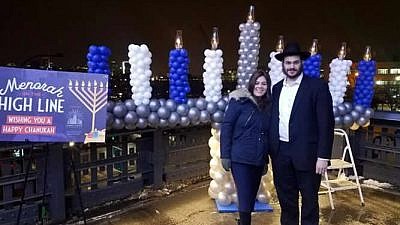
From Gabi and Rivky, and her time at Mumbai Chabad, “I learned to trust Jews very different than you,” she says. “And to be really welcoming, radically welcoming.”
With the passing of years, certain details crystallize. How young Gabi and Rivky were, how difficult their lives had been, and how much they accomplished in such a short time span. Beser had had a deep respect for Rivky Holtzberg since her time in Mumbai, but it was getting married and having her own child that drove it all home.
“She was an amazing woman and person, with a such a tremendous faith in G‑d,” says Beser. “I’m a mother now. I think about what she went through, how brave she was, and how much I would have loved to tell her about my son.”
That’s another thing that comes into focus again on the decade anniversary of the Mumbai attacks: how deep the loss was, and how big the shoes to be filled.
This article originally appeared on Chabad.org. News.


























